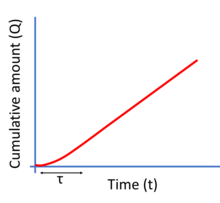Drug permeability
In medicinal chemistry, Drug Permeability is an empirical parameter that indicates how quickly a chemical entity or an active pharmaceutical ingredient crosses a biological membrane or another biological barrier to become bioavailable in the body. Drug permeability, together with drug aqueous solubility are the two parameters that define the fate of the active ingredient after oral administration and ultimately define its bioavailability.[1] When drug permeability is empirically measured in vitro, it is generally called apparent permeability (Papp) as its absolute value varies according to the method selected for its measurement. Papp is measured in vitro utilizing cellular based barriers such as the Caco-2[2] model or utilizing artificial biomimetic barriers, such as the Parallel Artificial Membrane Permeation Assay (PAMPA)[3] or the PermeaPad.[4] All these methods are built on an acceptor compartment (from 0.2 up to several mL according to the method uses) where the drug solution is placed, a biomimetic barrier and an acceptor compartment, where the drug concentration is quantified over time. By maintaining sink condition, a steady state is reached after a lag time (τ, Fig. 1) .
Data Analysis

The drug flux represents the slope of the linear regression of the accumulated mass (Q) over time (t) normalized over the permeation area (A), i.e., the surface area of the barrier available for permeation.
Equation 1:
The drug apparent permeability (Papp) is calculated by normalizing the drug flux (j) over the initial concentration of the API in the donor compartment (c0) as:
Equation 2:
Dimensionally, the Papp represents a velocity, and it is normally expressed in cm/sec. The highest is the permeability, the highest is expected to be the bioavailability of the drug after oral administration.
See also
References
- ^ Amidon, G. L.; Lennernäs, H.; Shah, V. P.; Crison, J. R. (March 1995). "A theoretical basis for a biopharmaceutic drug classification: the correlation of in vitro drug product dissolution and in vivo bioavailability". Pharmaceutical Research. 12 (3): 413–420. doi:10.1023/a:1016212804288. hdl:2027.42/41443. ISSN 0724-8741. PMID 7617530. S2CID 21085622.
- ^ Artursson, P.; Karlsson, J. (1991-03-29). "Correlation between oral drug absorption in humans and apparent drug permeability coefficients in human intestinal epithelial (Caco-2) cells". Biochemical and Biophysical Research Communications. 175 (3): 880–885. doi:10.1016/0006-291x(91)91647-u. ISSN 0006-291X. PMID 1673839.
- ^ Kansy, M.; Senner, F.; Gubernator, K. (1998-03-26). "Physicochemical high throughput screening: parallel artificial membrane permeation assay in the description of passive absorption processes". Journal of Medicinal Chemistry. 41 (7): 1007–1010. doi:10.1021/jm970530e. ISSN 0022-2623. PMID 9544199.
- ^ di Cagno, Massimiliano; Bibi, Hanady A.; Bauer-Brandl, Annette (2015-06-20). "New biomimetic barrier Permeapad™ for efficient investigation of passive permeability of drugs". European Journal of Pharmaceutical Sciences. 73: 29–34. doi:10.1016/j.ejps.2015.03.019. ISSN 1879-0720. PMID 25840123.
External links
- Permm server and database, a computational tool for theoretical assessment of passive permeability of molecules across the lipid bilayer


